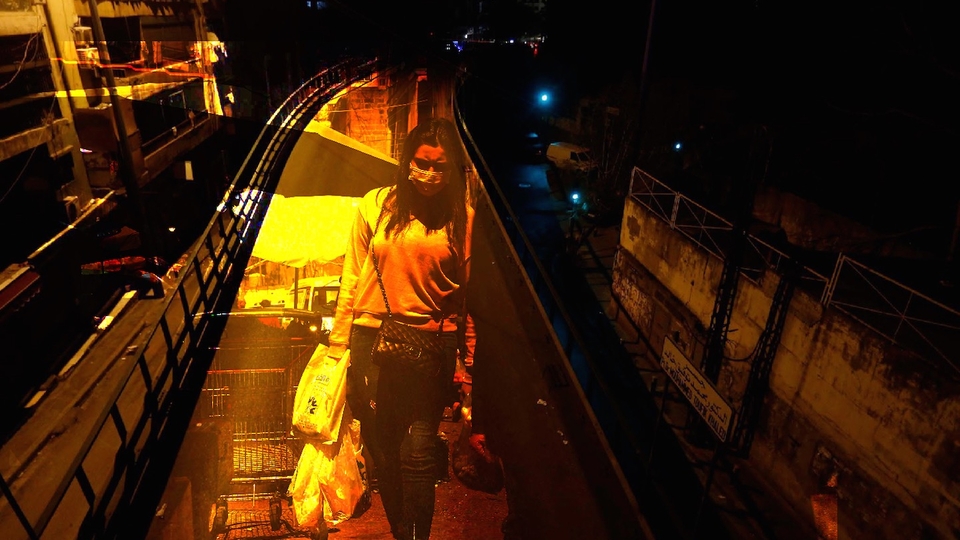“We Didn’t Even Try”: How Lebanon's Chaotic COVID-19 Strategy Let Thousands Die
Ali Chehade used to fill any moment of silence by singing traditional tunes, some so old that his granddaughter Batoul Chehade could not recognize them. Every once in a while, she, her father, and her brother would visit their grandfather Ali in Sour. He took them to his favorite butcher to eat fresh grilled meat for breakfast, and he teased Batoul for her appetite.
One afternoon in December, his neighbor Samia Yaacoub met him bringing back a harvest of pomelo from his land. He insisted on giving her some; she said she would take her share later, after she went to the market. It was the last time she saw him.
At first, Ali had symptoms of what his family confused for a cold. But his symptoms worsened, and he was hospitalized. On December 21, 2020, Ali, a healthy 80-year-old, lost a painful battle with COVID-19.
The songless silence fell heavy on his wife, children, grandchildren, and friends. “It wasn’t his time yet,” said Batoul, who described her grandfather as a strong, healthy, and kind man.
Her grandparents did not know how deadly the virus was, or the importance of social distancing and masking, said Batoul. She believes a clearer information campaign from the government and stronger preventive measures would have saved his life.
Ali Chehade is one of 7,769 people who have died from COVID-19 in Lebanon as of this publication. By the time he died, the Lebanese government had spent nine months trying to contain the outbreak — and failing repeatedly. Shortly after Ali passed away, Lebanon allowed restaurants and bars to reopen for the holidays, causing a surge in coronavirus deaths that lasted several months and reached an average of a hundred deaths daily in late January and early February.
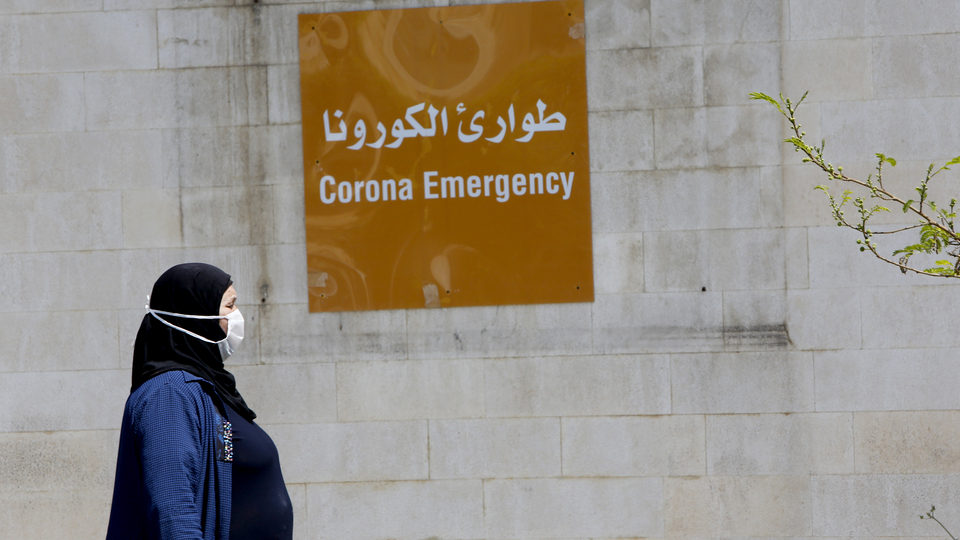
A woman passes by a "Corona Emergency" sign at Rafik Hariri University Hospital. Beirut, Lebanon. April 17, 2020. (Marwan Tahtah/The Public Source)
Lebanon’s death toll has been steadily decreasing since mid-April, but people are still dying every day. Lebanon’s government has at least 10 official COVID-19 committees, as well as several advisory entities answering to parliament, syndicates, and ministries. But over a year into the pandemic that gave rise to competing and overlapping committees, none have come up with a comprehensive plan to manage the spread of the virus.
Public health experts fear that without a cohesive strategy, Lebanon could tip back into an uncontrolled outbreak — or incubate a deadly variant, especially given that vaccination rollout is slow and vaccine hesitancy remains high. “There is still no road map or actionable COVID-19 response strategy,” said public health expert Sara Chang, in an interview conducted over direct message on Twitter. “[W]hat will happen when/if cases begin to increase again?”
Public health experts fear that without a cohesive strategy, Lebanon could tip back into an uncontrolled outbreak — or incubate a deadly variant, especially given that vaccination rollout is slow and vaccine hesitancy remains high.
A small but experienced group of doctors and scientists, the Independent Lebanese Committee for the Elimination of COVID-19, is urging Lebanon to adopt an array of long-term public health measures collectively known as “Zero COVID.” The dozen or so countries that put such measures in place have had relatively low infection and death rates. Some, like New Zealand and Australia, have already re-opened large businesses, held concerts in crowded stadiums, and gone back to pre-pandemic levels of social and economic activity. The strategy has also saved lives in lower middle-income countries like Vietnam and Cambodia, both of which have extremely low mortality despite the recent appearance of highly transmissible new variants.
The Independent Committee believes that the Lebanese state could have saved thousands of lives by following a few evidence-based steps: imposing tight regulations on airport arrivals; testing and isolating active cases quickly; communicating clear, consistent lockdown plans to the population; and accompanying lockdowns with financial support.
The Lebanese government has so far refused to consider any of the Independent Committee’s recommendations. But public health experts believe that a Zero-COVID strategy could still help Lebanon contain the spread of the virus — and potentially prevent the arrival of dangerous variants. They say it could also relieve the overwhelmed healthcare system, bolster the economy, and most importantly, avoid more preventable deaths.
“Daily we’re paying a price for not implementing a good strategy,” said Dr. Jade Khalife, an epidemiologist and public health expert who has worked in Lebanon’s public health sector for years. “Every day people are dying, but they didn’t need to die.”
What is Zero COVID?
Since last year, the debate over how governments should handle the pandemic has clustered around two poles: a so-called “Zero COVID” approach, where a hands-on government takes aggressive measures to control the spread of the virus; and a more laissez-faire approach that focuses on mitigating the effects of the disease while trying to avoid lockdowns.
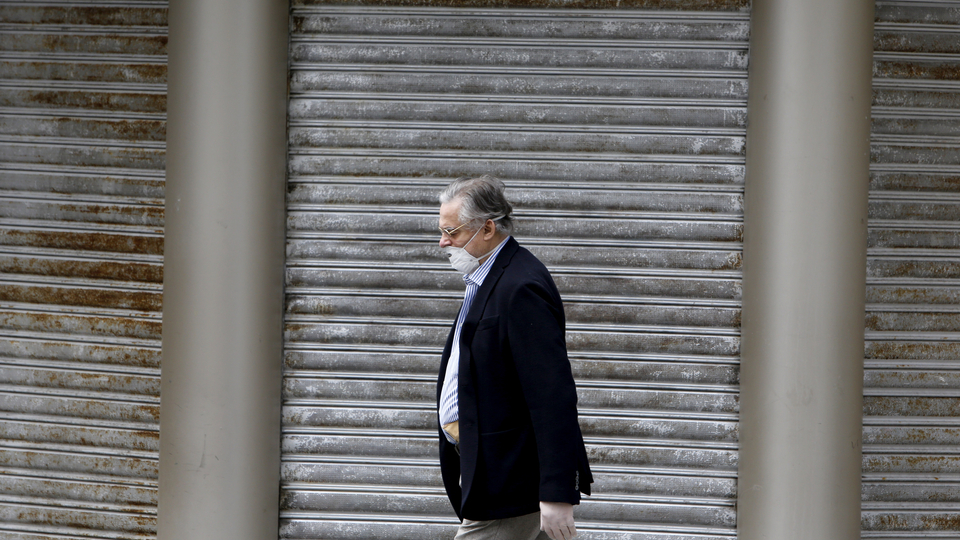
A man passes by a closed storefront during a nationwide lockdown. Beirut, Lebanon. April 2020. (Marwan Tahtah/The Public Source)
Zero COVID does not necessarily mean zero cases at all times. Rather, it aims to stop the transmission of the virus through four central principles: testing and contact tracing to quickly isolate active cases; targeted lockdowns in high-transmission zones; gradual, localized reopening; and strict international travel measures.
Vietnam was one of Zero COVID’s early success stories. The Communist state shut down schools in January 2020 and stopped international flights in March 2020. Until July 31, 2020 — six months into the pandemic — Vietnam had recorded no deaths at all.
Vietnam’s success in containing COVID-19 came with a cost: according to Human Rights Watch’s annual country report, the government increased already tight restrictions on freedom of speech, and failed to protect the right of privacy.
In late May 2021, the Vietnamese health minister announced that authorities had identified a highly transmissible coronavirus variant, a hybrid of two variants first detected in India and the U.K. Authorities in major cities closed public parks and nonessential businesses to contain the new variant.
But despite the current spike, Vietnam, a lower middle-income country of 96 million people, has only registered 48 deaths to date. A little more than half of the cases and 12 of the deaths were reported in the last month, according to the Johns Hopkins Coronavirus Resource Center.
By contrast, Lebanon — a country of only 6 million, classified as upper middle-income until its recent financial collapse — has registered 7,769 deaths. If Lebanon had Vietnam’s per capita death rate, that number would have been three.
Dr. Khalife believes that thousands of people would still be alive if Lebanon had adopted stronger and more consistent public health measures earlier in the pandemic. “Four thousand people that are dead today would have been alive if we had gone for Zero COVID [between September and November, and if we had prevented the surge after the holidays,]'' he said. “That's the cost of following a failing and ineffective strategy.”
“Four thousand people that are dead today would have been alive if we had gone for Zero COVID [between September and November, and if we had prevented the surge after the holidays,]'' he said. “That's the cost of following a failing and ineffective strategy.” —Dr. Jade Khalife, epidemiologist and public health expert
The Public Source decided to take a closer look at Dr. Khalife’s claim that Zero COVID measures could have saved 4,000 lives in Lebanon. We started from the beginning of the pandemic, in order to match the data from other countries. We then graphed the death rates in Lebanon compared to those of nine countries that contained the pandemic using a variety of different measures: some carried out variations of Zero COVID, like Vietnam and New Zealand; others, like Morocco and Uruguay, did not.
To calculate the number of avoidable deaths since March 2020, we followed a methodology developed by medical and public health experts at the National Center for Disease Preparedness at Columbia University.
- We calculated the number of COVID-19 related deaths per capita of the nine countries. This gave us the death rate per capita for each country.
- We then applied that rate to Lebanon’s population. This yielded the proportionate number of deaths that Lebanon would have registered, given that country’s death rate
—i.e., if Lebanon had followed a strategy that led to a similar death rate. - We then subtracted this theoretical number from the actual number of deaths in Lebanon (up to May 24). This is the number of deaths that Lebanon could have avoided, had the government adopted a strategy that led to the same or comparable death rate.
A bar chart shows the number of deaths that could have been avoided if Lebanon had followed a strategy that led to a similar death rates of nine different countries. Avoidable deaths range between 7,674 ( Vietnam's strategy) and 153 (Uruguay's strategy). The calculations were made on May 24, 2021, when Lebanon's death count was 7,677 and the country's population was estimated at 6,772,034 (World Population Review).
Fig.1: Avoidable deaths in Lebanon per each country's strategy
These numbers are theoretical. Lebanon’s geographic, economic, demographic and socio-political conditions differ significantly from those in each of these countries. None of these countries experienced a 2,750-ton explosion in the middle of the pandemic; Vietnam and Cambodia, however, both saw catastrophic flooding in the fall of 2020 that killed over 200 people, displaced over a million in Vietnam alone, and caused about $1.5 billion in damage.
A calculation that accounts for those variables would be much more complex and well worth doing. But in the meantime, the data suggest that if Lebanon had followed a better strategy since March — or any strategy — it could have prevented the deaths of many people like Ali Chehade.
A bar chart shows the number of deaths if Lebanon had followed a strategy that led to a similar death rates of nine different countries. Death tolls range between 3 ( Vietnam's strategy) and 7,524 (Uruguay's strategy). The calculations were made on May 24, 2021, when Lebanon's death count was 7,677 and the country's population was estimated at 6,772,034 (World Population Review).
Fig.2: Deaths in Lebanon per each country's strategy
"They Don't Let Us Work"
To understand how Lebanon’s fatalities reached a number so high, The Public Source looked at the various governmental committees. Lebanon currently has at least 10 officially sanctioned committees for its COVID-19 response. Nine fall under the Ministry of Public Health’s umbrella; one answers to parliament. None have complete authority.
Representatives of different committees have contradicted each other about lockdowns; scientific experts have struggled to advise the various committees; and despite an abundance of committees, their scattered decision-making powers have so far failed at planning and implementing a consistent strategy.
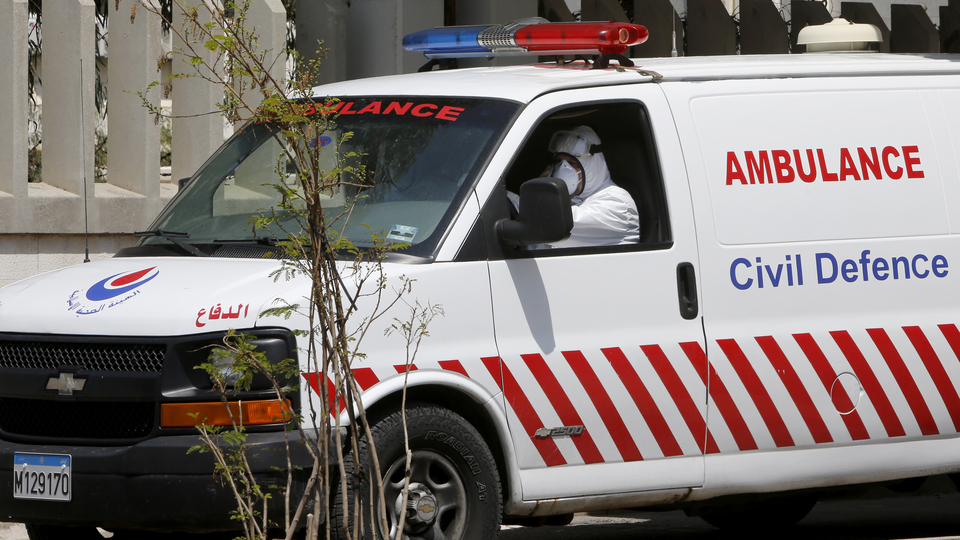
A Civil Defense ambulance pulls up at Rafik Hariri University Hospital. Beirut, Lebanon. April 17, 2020. (Marwan Tahtah/The Public Source)
“The governance of the COVID-19 response in Lebanon is dysfunctional,” said Dr. Fadi el-Jardali, a professor and internationally recognized expert on health policy and management.
For example, the parliamentary committee recommended closing businesses for the holidays and closing the airport after new variants appeared. But the ministerial committee refused, citing the country’s dire financial crisis, and carried out the disastrous holiday reopening that led to Lebanon’s worst fatalities.
“The communication is broken; some committees don’t talk to each other because of personal fights,” said Dr. Pascale Salameh, a professor of epidemiology at the Lebanese University and a member of the Independent Committee. “It makes you want to cry.”
“The communication is broken; some committees don’t talk to each other because of personal fights... It makes you want to cry.” —Dr. Pascale Salameh, Lebanese University professor of epidemiology
She has good reason. At the end of January 2020, a month before Lebanon registered its first case, the newly appointed government established a National Committee for COVID-19 to oversee national preparedness and pandemic response. The committee did not include a single epidemiologist, so Dr. Salameh volunteered.
In July 2020, Dr. Salameh proposed a project to collect and analyze demographic data on COVID-19 cases and deaths. She wanted to know who was getting sick and dying — their age, medical conditions, and what preventive measures they had followed. Such information is crucial to understanding how the virus is spreading, who is at most risk, and how to protect the population. The committee agreed, and appointed Dr. Salameh to lead the project.
And yet, despite the committee’s green light, the Ministry of Public Health refused to share any of the data that it collects from hospitals. During two months of back and forth, Ministry employees demanded volunteers and expert help, both of which she said she provided. But the Ministry never shared any of its data.
“They never said no, they never said they don't want to share the data,” Dr. Salameh said. “But the treatment and excuses led me to believe so.”
When she resigned from the committee and tried to collect the data on her own, the Lebanese Order of Physicians and the World Health Organization told her that other teams were working on a clinical register, and she had no right to collect the same data. She put the project on hold.
“I don't want to sit back, but I can't do more than this,” said Dr. Salameh, with clear frustration in her voice. “They don't let us work.”
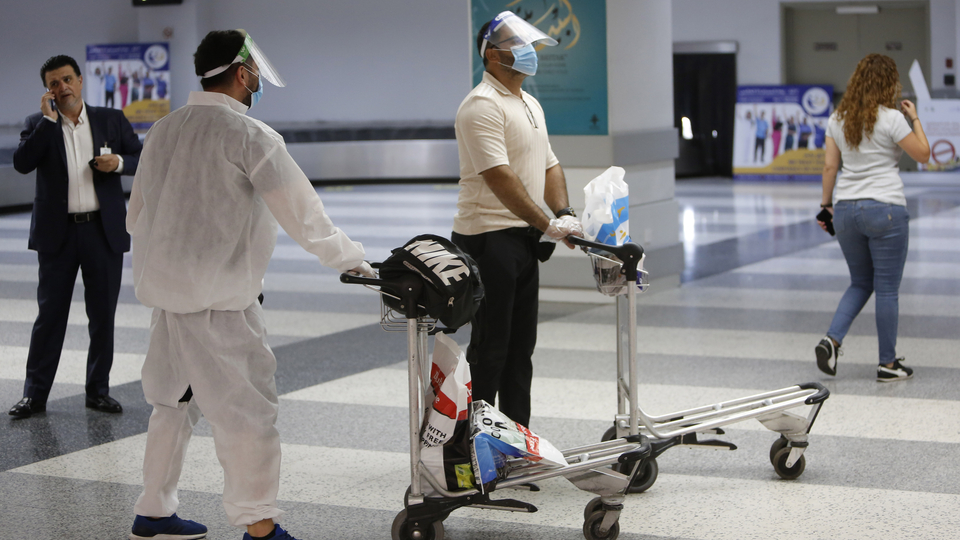
Two travelers in masks and face shields wait for their luggage at the Beirut International Airport. Lebanon. July 2020 (Marwan Tahtah/The Public Source)
She tried one last time. In November 2020, she joined the Epidemiology and Surveillance Unit Advisory Committee (ESU), a collaboration between the World Health Organization (WHO) and the Ministry of Public Health (MoPH).
“We only discussed how the data is presented — vertically, or horizontally,” she said. “I’m making it silly. But they are not letting us have deeper discussions on strategies, recommendations, lockdowns and vaccination rollout.”
The WHO said the role of the surveillance committee is to “to support the MoPH/ESU team in strategic planning and analysis, and reorientation of the ESU focus of work if needed.” They declined to comment on complaints from experts not being heard within the committee.
The Ministry of Public Health’s media advisor did not respond to several requests for comment.
Zero COVID In Lebanon
In October 2020, the Independent Lebanese Committee designed a Zero COVID plan for Lebanon: one national lockdown, with direct financial support, for four-to-six weeks — the time of two-to-three virus transmission cycles.
Under their plan, the central government and municipalities would divide regions into green zones, with no COVID-19 cases; red zones, with at least one; and yellow zones, with no COVID-19 cases, but a shared border with a red zone. In big cities, regions within the same municipality might need to be further divided.
“The idea is that as soon as you discover a case, you quickly isolate it, and you quarantine their contacts,” said Dr. Khalife. “So that way you maintain zero community transmission.”
Red zones would remain under complete lockdown until they go 14 days without registering any active cases. Green zones can start opening businesses and schools — giving people an incentive to comply.
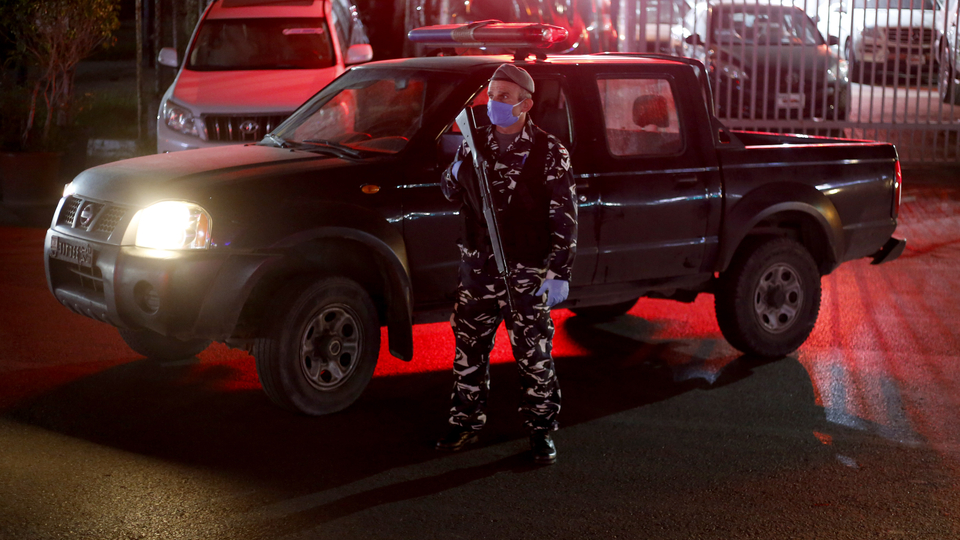
A police officer stands in front of a patrol car at night. Jal-El-Dib, Lebanon. April 2020. (Marwan Tahtah/The Public Source)
For this strategy to work, Lebanon’s government would have to reduce the turnaround time from PCR testing to within 24 hours and enforce travel restrictions across zones. The Independent Committee also laid out requirements for international travel, testing and quarantining of cases.
“This strategy certainly provides a stepwise and clear approach to responding to this pandemic based on accurate assessment of data,” said Dr. El-Jardali, who was not involved in the Independent Committee’s plan.
But Lebanon does not have the technology infrastructure required for precise mapping of cases, Dr. El-Jardali pointed out. And zoning works better when people are relatively static; in Lebanon, many people can’t afford to live and work in the same neighborhood.
With a lack of proper healthcare infrastructure, and mismanagement of state funds, the next question is whether Lebanon can support a social safety net, cash assistance, testing and tracing, as well as isolating active cases. Lebanon’s COVID response has relied heavily on international assistance, financed largely through the World Bank.
Nabil Rizkallah, a member of the National COVID Committee and advisor to the Ministry of Labor, said the NCC’s strategy only differs from Zero COVID on two points: border closure and financial support — both of which are crucial for the strategy to succeed.
Rizkallah’s assessment of the Independent Committee’s Zero COVID plan typified the government’s response. Lebanon’s January lockdown was among the strictest in the world, and while the compliance rate fluctuated, it reached an impressive 94 percent. Yet Rizkallah claimed Lebanon’s population was too irresponsible to handle Zero COVID measures: “There isn't a police force large enough that can implement this in Lebanon,” he said, adding that “the population is not very disciplined.”
“Go Walk Around Your House”
Every weekend, Mariam el-Shafie walks 5 kilometers in Horsh Beirut or on the Corniche by the sea. In 2016, she suffered from a stroke that impedes her ability to walk and talk with ease. Since then, she needs weekly strolls, physiotherapy, and speech therapy in order to recover her motor skills and resume normal life.
A few months ago, during one of Lebanon’s repeated stay-at-home orders, a policeman approached el-Shafie as she was walking alone on the Corniche and told her she was not allowed to be outside.
When she explained her condition, and her urgent medical need for movement, he dryly told her: “Go walk around your house.”
El-Shafie believes that Lebanon’s repeated lockdowns have stalled her recovery. Her treatment centers closed their doors, and her walks became forbidden. “I would’ve recovered faster and better if it weren’t for the lockdowns,” she said.
El-Shafie believes that Lebanon’s repeated lockdowns have stalled her recovery. Her treatment centers closed their doors, and her walks became forbidden. “I would’ve recovered faster and better if it weren’t for the lockdowns,” she said.
At the beginning of the pandemic, many people embraced the strict measures that kept Lebanon safe. Now, driven by frustration and a false sense of security, and in the absence of a clear and consistent information campaign, they are more likely to break the government’s recommendations. With every new lockdown and reopening, a phenomenon that Dr. Jade Khalife has called “yo-yo lockdowns,” people comply less and less.
When the Independent Committee designed the plan, in October 2020, they assumed people would comply the way they did during the country’s first lockdown. But that compliance decreased after multiple lockdowns, because of a lack of financial support and any concrete result.
Google’s Community Mobility Reports show that during the first lockdown from mid-March 2020 to the end of April, commutes to all destinations, including workplaces, stores, and pharmacies, were consistently lower than the baseline. But during subsequent lockdowns — in August, September, and November 2020, as well as the most recent, in February 2021 — mobility trends never decreased as much as they did during the first.
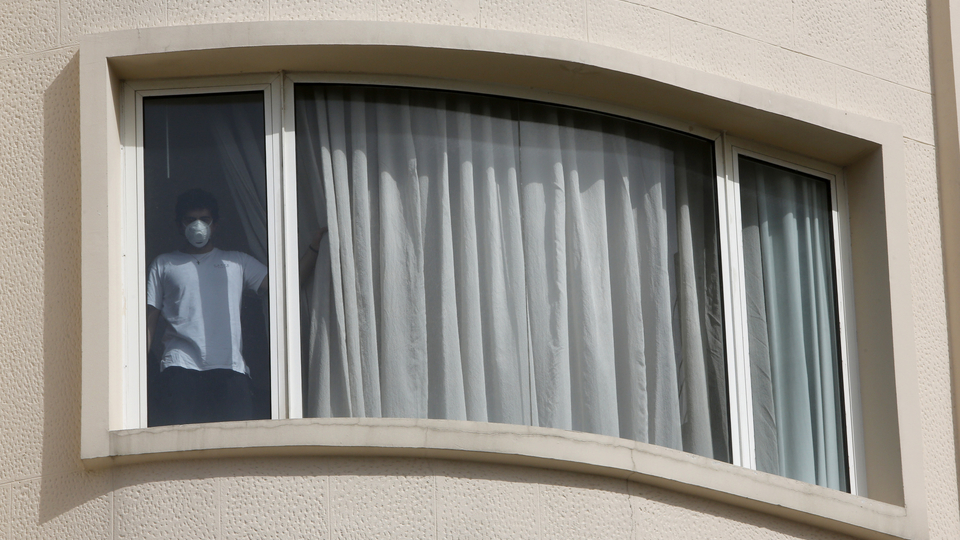
A man wearing a mask stands at the window of his apartment. Beirut, Lebanon. May 2020. (Marwan Tahtah/The Public Source)
Dr. Khalife believes that a six-week lockdown at the beginning of the pandemic would have allowed the country to reopen safely and almost entirely. Mariam could have been walking and going to therapy instead of being locked in over months of “yo-yo” lockdowns.
“Every day, people are getting their health harmed, and that was completely preventable,” he said. “As time goes on, it gets more costly not to have taken this decision.”
Today, a year and two months into the COVID-19 pandemic, Lebanon has just emerged from an extended risk of uncontrolled outbreak. Many businesses have reopened with a disorganized implementation of social distancing measures. The number of cases has dropped; the virus is spreading at low levels but is not contained yet, according to data presented by Sara Chang, the public health expert, who shares COVID-19 data summaries every week.
“With other infectious diseases, we've only ever reached herd immunity through vaccines,” said Chang. “It is likely COVID-19 will be no different. Vaccines are the best tool we have to prevent severe illness and death.”
To date, only 4.1 percent of the population is fully vaccinated, and a vaccination campaign that excludes Lebanon’s migrant and refugee populations is a recipe for failure.But herd immunity looks increasingly unlikely for any country. Vaccination of a large number of people in Lebanon is at least a year or more away: To date, only 4.1 percent of the population is fully vaccinated, and a vaccination campaign that excludes Lebanon’s migrant and refugee populations is a recipe for failure. If Lebanon doesn't aim to eliminate transmission, the virus will continue spreading, pointed out Dr. Salameh. The longer it circulates through the population, the higher the risk of dangerous mutations like the one recently discovered in Vietnam.
And for many survivors of COVID-19, the damage is already done. Countless are quietly suffering from lingering symptoms, weeks and months after they recover. They experience fatigue, brain fog, a loss of taste and smell, shortness of breath, cough, joint pain, and chest pain. In rare cases, patients have developed complications with inflammation, kidney and lung problems, putting them at higher risk of death from other causes than COVID-19.
“Countries who had this [Zero COVID] strategy went back to normal,” said Dr. Salameh, “and here we didn't even try."
